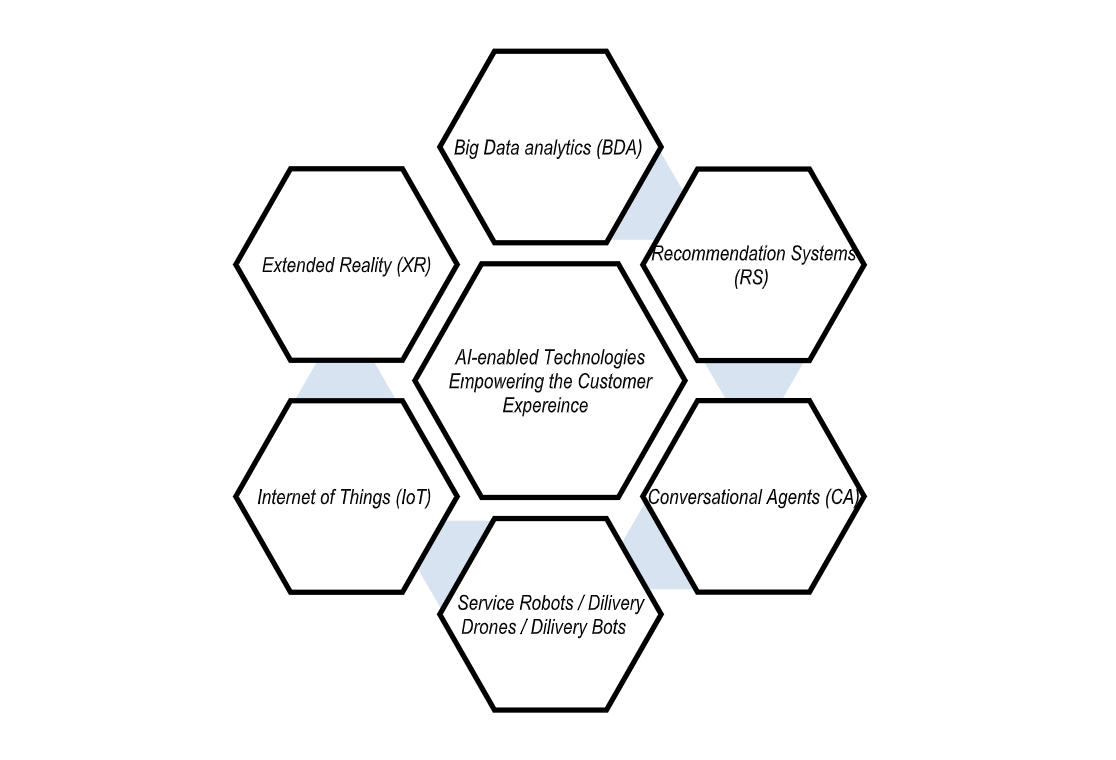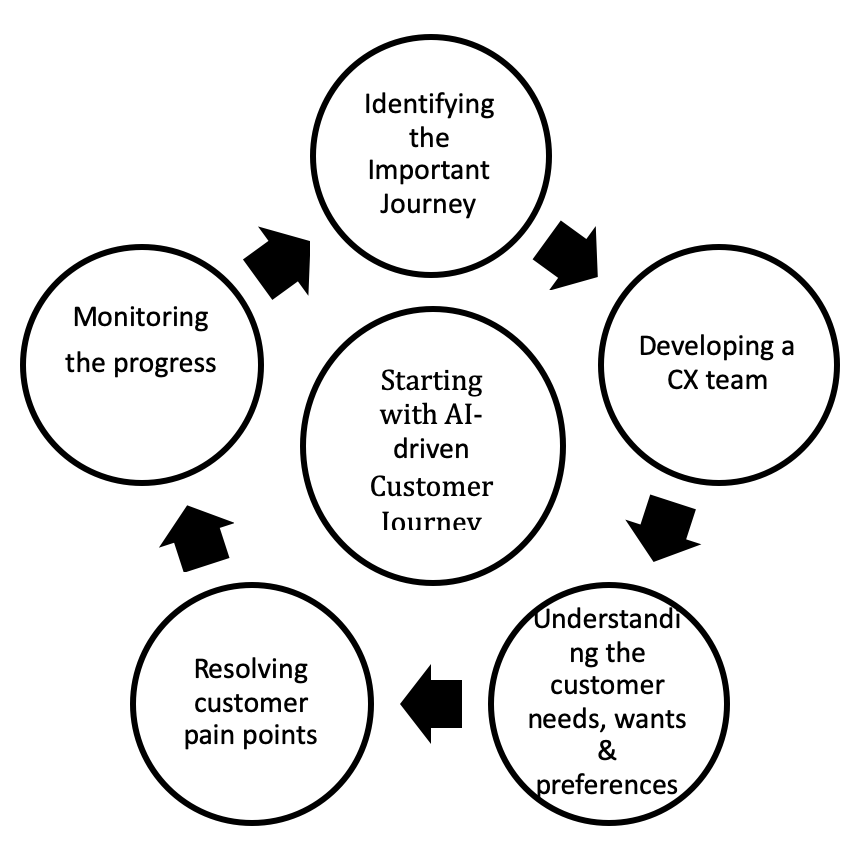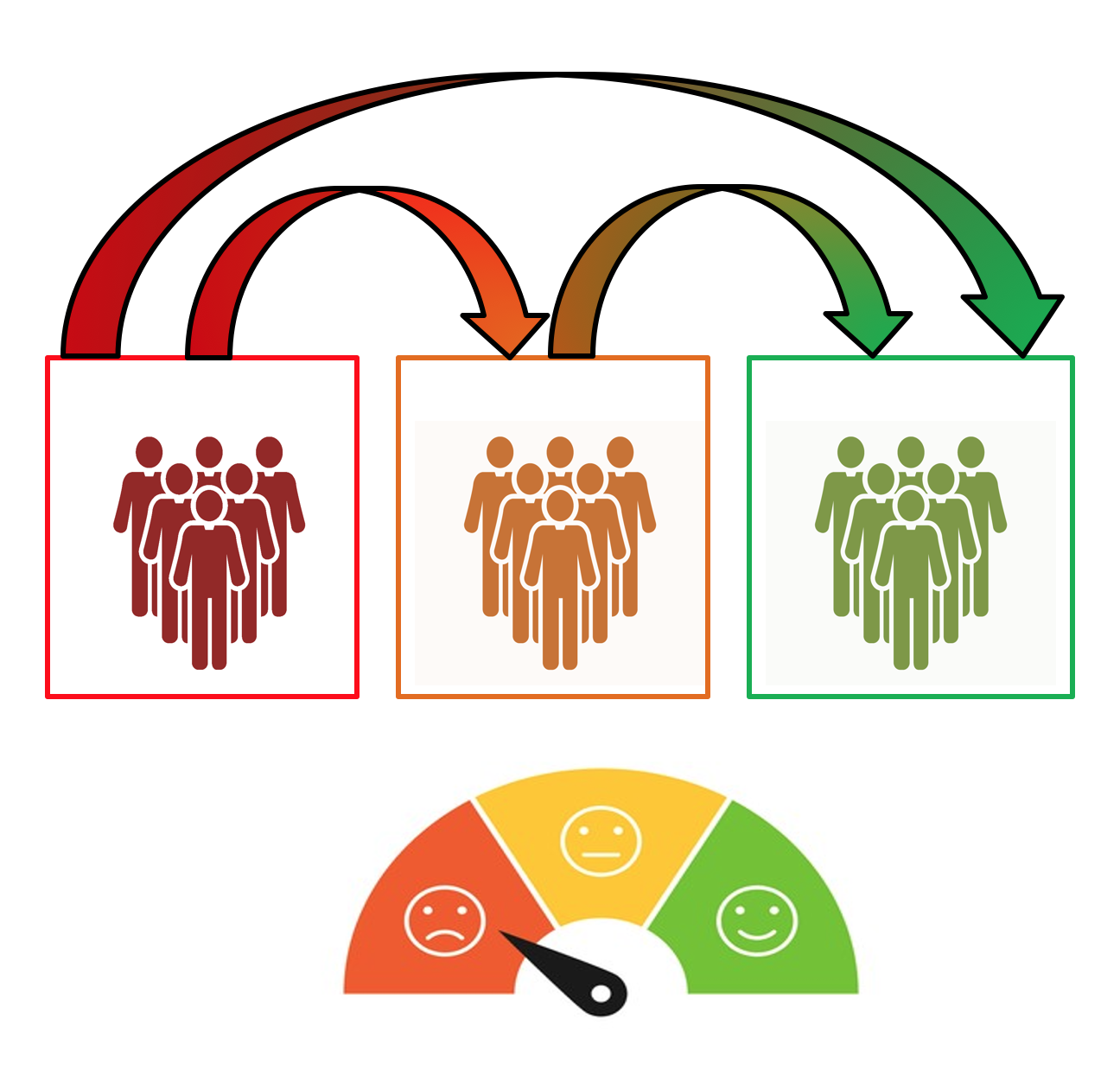California Management Review
California Management Review is a premier academic management journal published at UC Berkeley
by Rijul Chaturvedi
by Rijul Chaturvedi and Sanjeev Verma

Image Credit | Markus Winkler
Entering the fourth industrial revolution, companies invest more in new, emerging, AI-based technologies. How can these technologies enhance the customer experience and can revolutionize businesses? How can companies overcome the challenges faced when adopting AI-based technologies? Can we resolve the personalization-privacy paradox? How can journey mapping analytics help in reducing customer churns?
“Understanding the Role of Artificial Intelligence in Personalized Engagement Marketing” by V. Kumar, Bharath Rajan, Rajkumar Venkatesan, and Jim Lecinski. (Vol. 61/4) 2019.
“Demystifying AI: What Digital Transformation Leaders Can Teach You about Realistic Artificial Intelligence” by Jürgen Kai-Uwe Brock and Florian von Wangenheim. (Vol. 61/4) 2019.
“A Brief History of Artificial Intelligence: On the Past, Present, and Future of Artificial Intelligence” by Michael Haenlein, Andreas Kaplan. (Vol. 61/4) 2019.
These days, customers are becoming digital savvy; this can emerge as the biggest growth opportunity for the companies. They can now create customer experiences far more influential than ever before.1 Complex and time-consuming things become a cakewalk with a single click. Practitioners are moving to AI for enhanced customer experiences in the age of the fourth industrial revolution.2 AI provides multiple offerings, including automation, personalization, future prediction, recommendation, etc.3 A global online survey on senior managers and executives conducted in 2016-2017 reveals that only 15 % of firms do not have any AI plans.4Artificial intelligence unfolded avenues for competitive advantage, but it is not free from challenges.5 For example, it is not easy to redesign the entire system with AI-based technologies in one go.19 Second, AI offers personalization, but at the cost of compromised privacy (personalization-privacy paradox).24 Third, consumers’ transmigration between brands and customer churns holes in profitability, even after high capital investment in implementing such technologies.7
Scant is known for overcoming these challenges when adopting and implementing AI-based technologies. This article presents the array of emerging technologies and offers a framework for organizational transformations with the AI-driven customer journey. The article aims to resolve the personalization-privacy paradox by introducing a solution matrix separating personalization from privacy concerns. Moreover, the article proposes a framework for reducing customer churns with AI-based customer journey mapping analytics.
Moving ahead of digital transformations, AI-driven approaches such as data science and new technologies like extended reality, robots, recommender systems, the internet of things and conversational agents, etc., are the modern ways to improve customer experience. According to a Bain & Company survey, most organizations incorporate AI-Based customer experience tools for sustainable competitive advantage8. The following section of the article addresses six emerging AI-enabled technologies that can transform the customer experience.

2.1 Big data analytics (BDA)
The growing popularity of online shopping and digital marketing has opened an ocean of customer insights through big data such as customer health, transaction, location, preference, choice, likes, dislikes, GPS signals, and feedbacks.9 Big data keep piling with a gold mine of customer insights to provide better services and products. The speed of data and its velocity is important in the internet world. Leading organizations are interested in real-time data such as GPS location to track orders online. Heap of raw data converted into valuable insights forecast demands, predict consumer behavior, next purchase, etc. Big data analytics helps managers with decision-making, forecasting, and other management activities through descriptive, predictive, and prescriptive analytics. Amazon’s anticipatory shipping surprises customers with products they could think to buy in the future.6 Companies that identify themselves as data-driven are performing better in objective measures and financial operations. In the age of competition on analytics, leading organizations such as Amazon and Google leverage competitive advantage based on BDA.10
2.2 Recommendation Systems (RS)
e-Commerce offers an abundance of information and choices, however, having access to a large amount of information can lead to information fatigue and dissatisfaction in decision making.3 To overcome this challenge, AI-powered recommender systems help customers make the right choices by recommending the right products and services.11 Recommender systems aggregate recommendations received from people as input and direct them to appropriate seekers.12 The recommender system takes various forms based on underlying algorithms. For example, content-based recommender systems use behavioral data, whereas collaborative recommender systems use historical data of a community to recommend.13 Hybrid recommender systems use different combinations of algorithms to optimize recommendations.
2.3 Conversational Agents (CA)
Another AI-powered technology that has revolutionized the business is conversational agents (CA). CA is a new form of communication between brands and consumers, where a digital/voice assistant interacts with the consumers. When buying activities by consumers are done through a digital assistant, it is referred to as conversational commerce. According to a PWC report, customers use digital assistants for daily chores like ordering food, listening musing, buying products, etc.14 Apple’s Siri, Microsoft’s Cortana, Amazon’s Alexa, and Google’s assistant are intelligent personal assistants that assist users in providing convenience and a better experience. Moreover, according to the requirement, digital assistants can work as a companion or a friend, home or office assistants, etc.
2.4 Service robots/ Delivery Drones/ Delivery Bots.
Advanced technologies such as service robots inbuilt with AI features, biometrics, image processing, etc., have immense opportunities to improve the customer experience. Service robots can be physically embodied robots and can be in virtual formats in the future. For example, shopping malls, hospitals, hotels, airports, railway & metro stations, etc., could install hologram-based service robots to assist consumers in dealing with common questions. Holograms neither take floor space nor requires high-cost hardware.15 Similarly, delivery drones and bots can quickly deliver food parcels or lightweight products at the consumer’s doorstep. This mode of delivery would be cost-effective, environment friendly, and attractive to the users.16
2.5 Internet of Things (IoT).
A network of connected things, devices, and people that interact through the internet is IoT.17 Future devices and home appliances such as washing machines, televisions, refrigerators, microwaves, air conditioners, etc., would automatically operate through complex sensors. Imagine your refrigerator automatically orders fruits, milk, eggs, bread, butter, and vegetables online, according to the stock left in the specific containers. Shortly, all devices would be advanced and smarter through the internet of things. IoT has immense potential to transform the shopping experience. With the help of IoT, information like price, usage, manufacturing date, specifications, expiry date, etc., could be displayed by the product itself through wearables or smartphones.
2.6 Extended Reality (XR)
Augmented Reality (AR), Virtual reality (VR), and Mixed Reality (MR) enhance our view of the real world and are known as extended reality. AR enhances the real view with the help of computer-generated information, Instagram filters, Lenscart 3D mirror, IKEA applications are perfect examples for (AR). VR replaces the user’s view and provides a virtual environment on a 3D wearable frame. VR found its applications in myriad areas like gaming and entertainment, and gradually its usage is expanding in training, education, and healthcare services.18 VR has also unfolded avenues for the tourism industry as VR devices can make the tour experience possible at one’s residence itself. MR merges the real and virtual worlds and can project a virtual reality environment in natural surroundings. Imagine a shopping experience where customers enter a vegetable shop and find themselves in a mixed reality of a farm. They can pluck fruits and veggies from the crops and trees that are nothing but the part of a hoax environment created with mixed reality.
Above mentioned technologies unfold enormous possibilities to enhance the customer experience across customer purchase journeys. Businesses need to develop an AI-driven customer journey to provide a magical experience to their customers.
Customer satisfaction ratings can be high for a particular touchpoint and low for the entire journey, as it is the journey that creates the customer experience. It requires high capital investment and change management for companies to design an AI-driven process. Thus, it is always good to identify customer pain points and essential journeys first to start with.

3.1 Identifying the important journey
Isolated processes can be divided into fair sets of end-to-end customer journeys.19 For example, regional transport offices offer various services - issuing a driving license, registration of vehicles, transfer of vehicle ownership, etc. Each service is associated with an entirely different customer journey as their objectives differ.
Not all the journeys are equally important; McKinsey’s annual North American customer-experience survey finds only four journeys to contribute to customer satisfaction. Those are billing and payment journey, managing energy usage, outage, and resolving billing and payment issues.20 Payment journeys can be enhanced in various ways. First, biometrics can improve customer pay and checkouts, such as Amazon Go stores and fast tag services. Second by improving the post-purchase period through real-time chargebacks. Third, online financing and online insurance based on customer data.21 Examining customer journey can identify the core driver of satisfaction. For example, live tracking of customers’ orders on their smartphone improves satisfaction far better than any other transformation in the entire customer’s journey.
3.2 Developing a CX (Customer Experience) team
Transformation requires a cross-functional team consisting of data scientists, process engineers, business managers, technology specialists, domain specialists’, etc. The CX team is responsible for understanding customer behavior in real-time and acting accordingly to make the process more agile, strong, and personalized. Tracking the individual customer journey can bring a seamless experience to customers. Customers can be benefited from a positive experience through some compensation if they face any pain point in the journey. For example, a study on a leading fast food restaurant reveals – falling of food items from the table while eating, is taken as a severe event in the customer journey and the staff of the restaurant serves another dish to the customer, without charging any extra bill on the new dish. Here the individual journey is more important to such restaurants, and customers are delighted with a memorable experience.
3.3 Understanding the customer behavior, needs, wants, and preferences.
Personalization across the customer journey can be achieved through a customer-centric view and a better understanding of customer behavior.22 For example, Banks can offer various policies based on the CIBIL scores, transaction history, and other such data. Other elements include customer instant alerts and reminders based on past transactions through messaging and customer engagement through automated voice agents. For example, telecommunication services indicate to their customers when they are running out of validity through automated calls and messages. There are advanced methods for understanding the CX. As discussed previously, companies can access various forms of data from the internet instead of directly asking customers about their preferences via survey. For example, leading e-commerce websites & travel agencies analyze customer reviews on their websites or on different social media platforms.6
3.3.1 Resolving the Personalization-Privacy Paradox
According to a BCG survey report, only 29 percent of consumers accept that data results in better services, whereas 75 percent of consumers are concerned for their privacy and now limit themselves from sharing any personal information online.23 Customers trade their privacy with personalization and this conundrum is referred to as the personalization–privacy paradox.24 The following matrix is proposed to solve this paradox:

Privacy assurance reduces the feeling of loss of control as this entails privacy promises such as “we will not collect your data without your permission,”; “we will not disclose your data to any third party,” “we will protect and secure your personal information” etc. Reduced feelings of loss of control can reduce privacy concerns and increase the usefulness of the services because customers are willing to share information if they are assured of security and control.25 Marketers adopt personalization as it provides advantages such as convenience, individualization, and efficiency.26
Matrix resolving Personalization – Privacy paradox is a planning tool to design a secure and customer-centric service strategy that links convenience with the feeling of loss of control. It presents four alternative consequences of using customer data in a 2 X 2 matrix. Two dimensions of the matrix are - the Feeling of loss of control (Low or High), and the Convenience (Low or High). The sequence of consequences of using customer data are as follows:
Only Privacy Concern – Businesses offering low convenience with high loss of control reduce the usefulness of the service. Such services cannot exhibit personalization to the customer; it is only the privacy concern left in the consumer’s mind. It is because customers trade their information with convenience. Reduced comfort level, will appear as a risk to their privacy.
Personalization with Privacy Concern –This seems to be a common consequence of using customer data. To provide better and higher convenience to the customers, companies tend to use personal information such as past purchase history, transaction details, preferences, search history, etc. This brings privacy concerns with personalization, and eventually, most consumers limit themselves from sharing any private information online 23. Hence, the loss of control over information generates distrust or insecurity towards their privacy regardless of the personalization feature offered.
Customization – When businesses offer specific product or service specifications that suit customer requirements, it is called customization. This product or service customization strategy has been significant throughout the years.27 Customers have to modify product design according to their requirements in case of customization, whereas no user efforts are required in the case of personalization 28. This situation with low convenience and low loss of control can be interpreted as customization.
Only Personalization – Although customers usually feel insecure about their privacy while using personalized services, this assumption may not hold true all the time. Yes! Surprisingly, if sufficient privacy assurance is provided to the customers, they might not be concerned about their private information misuse or leakage, which can surely resolve the personalization-privacy paradox.
3.3.2 Framework to reduce Customer Churn using data analytics:
Companies must look for a real-time customer feedback system throughout the journey to provide 360-degree customer-centric insights to the managers. For example, if a customer enters the map of the customer journey of a firm having several touchpoints in the journey, the customer can experience service failure at any random point from first to last. The continuous feedback system will alert the staff at the next touchpoints to treat the particular customer with some compensation. This advanced customer treatment can only be operated through journey mapping analytics.
Customer profiles can help the organization in reducing customer churn. Machine learning algorithms on customer data can predict the customer churn, the reason behind churn, and methods to retain them.
The following figure represents a framework to reduce customer churn that shows three sets of customers; the first is the Red customers: identified with a low satisfaction rating after a particular service or product consumption. The yellow customers: with a medium satisfaction rating and the green customers: with a high satisfaction rating.

Now once the customers are segmented as red, yellow, and green, the next journey of customers could be entirely different for them. The objective of customer segmentation is to shift the customers from red and yellow boxes to green boxes. Companies can identify customers with service failure or service delay experiences and provide them with compensation to save the relationship with them as done by a leading airline. 29
3.4 Resolving Customer Pain points.
There can be many pain points in the journey, identifying and resolving the most significant one is the job. For example, banks observed customers’ frustration while standing in a long queue and provided a digital token system to their customers, eliminating the need to stand in the queue. Pain points can be identified by examining all the touchpoints throughout the customer journey, starting from pre-purchase to purchase and then post-purchase stages. AI agents can speed up and eliminate pain points of customer care services through complaint booking, complaint resolving, receiving, and canceling the order.
3.5 Monitoring the Progress.
A continuous feedback system enabled with big data analytics strengthens the journey mapping and monitoring of the system. Today firms are automating the controls and monitoring process with the help of AI and Machine learning. Real-time monitoring of the operations can improve customer journeys, enabling companies to provide seamless and rich customer experiences.
AI-enabled technologies such as big data analytics, recommendation systems, conversational agents, service robots/delivery bots, the internet of things, extended reality, etc., can be deployed in various service sectors to enhance the customer experience. Although deploying AI, help achieve a high competitive advantage, there exist challenges. Transformation requires huge capital investment and change management to redesign the entire system with AI. The first step is to identify the critical journey; second to develop a CX team; third to understand the customer needs; fourth to resolve the customer pain points, and fifth is to monitor the progress. AI offers personalization on the cost of privacy concern and thus a solution matrix is proposed to resolve the personalization-privacy paradox. At the same time, even after high capital investment to implement such advanced technologies, customers can still switch to other brands due to aggressive competition in the market. Therefore, the article also proposed a framework to reduce customer churn using AI analytics. In turn, businesses and consumers are expecting an increased standard of living with AI-based technologies. This article can guide the practitioners and managers seeking smooth transformation in the organization. The study creates a pathway for overcoming the challenges faced when adopting the AI-driven approach to enhance the customer experience.
Bharat Poddar, Yogesh Mishra, and Anandapadmanabhan Ramabhadran. Transform Customer Journeys at Scale—and Transform Your Business. The Boston Consulting Group (BCG) (2019). Accessed from https://www.bcg.com/en-in/publications/2019/transform-customer-journeys-scale-transform-business
Sanjeev Verma, Rohit Sharma, Subhamay Deb, and Debojit Maitra. “Artificial intelligence in marketing: Systematic review and future research direction.” International Journal of Information Management Data Insights (2021): 100002.
V. Kumar, Bharath Rajan, Rajkumar Venkatesan, and Jim Lecinski. “Understanding the role of artificial intelligence in personalized engagement marketing.” California Management Review 61, no. 4 (2019): 135-155.
Jürgen Kai-Uwe Brock, and Florian Von Wangenheim. “Demystifying AI: What digital transformation leaders can teach you about realistic artificial intelligence.” California Management Review 61, no. 4 (2019): 110-134.
Michael Haenlein, and Andreas Kaplan. “A brief history of artificial intelligence: On the past, present, and future of artificial intelligence.” California management review 61, no. 4 (2019): 5-14.
Gijs Overgoor, Manuel Chica, William Rand, and Anthony Weishampel. “Letting the computers take over: Using AI to solve marketing problems.” California Management Review 61, no. 4 (2019): 156-185.
Ali Tamaddoni Jahromi, Stanislav Stakhovych and Michael Ewing. “Managing B2B customer churn, retention and profitability.” Industrial Marketing Management 43, no. 7 (2014): 1258-1268.
Gerard du Toit, James Anderson, and Richard Hatherall. Customer Experience Tools and Trends: Let No Tool Stand Alone. Bain & Company (2020). Accessed from https://www.bain.com/insights/customer-experience-tools-and-trends-2020-let-no-tool-stand-alone/
Andrew McAfee and Erik Brynjolfsson. Big Data: The Management Revolution, Harvard business review. (2012) Accessed from https://wiki.uib.no/info310/images/4/4c/McAfeeBrynjolfsson2012-BigData-TheManagementRevolution-HBR.pdf
Thomas H. Davenport. Competing on analytics. Harvard business review (2006). Accessed from http://hosteddocs.ittoolbox.com/competinganalytics.pdf
Xinrui Zhang & Hengshan Wang. Study on recommender systems for business-to-business electronic commerce. Communications of the IIMA (2005), 5(4), 8.
Paul Resnick & Hal. R. Varian. Recommender systems. Communications of the ACM (1997). 40(3), 56-58.
Yashar Deldjoo, Markus Schedl, Paolo Cremonesi, and Gabriella Pasi. “Recommender systems leveraging multimedia content.” ACM Computing Surveys (CSUR) 53, no. 5 (2020): 1-38.
Janarthanan Balakrishnan and Yogesh K. Dwivedi. “Conversational commerce: entering the next stage of AI-powered digital assistants.” Annals of Operations Research (2021): 1-35.
Jochen Wirtz, Werner H. Kunz and Stefanie Paluch. The Service Revolution, Intelligent Automation and Service Robots. The European Business Review (2021). Accessed from https://www.europeanbusinessreview.com/the Service Revolution, Intelligent Automation and Service Robots/
Wonsang Yoo, Eun Yu, and Jaemin Jung. “Drone delivery: Factors affecting the public’s attitude and intention to adopt.” Telematics and Informatics 35, no. 6 (2018): 1687-1700.
Jen Clark. what is the internet of things (IoT)? IBM business operations blog (2016). Accessed from http://www.ibm.com/blogs/internet-of-things/what-is-the-iot/
Jacob Hooker. xR, AR, VR, MR: What’s the difference in reality? Arm blueprint (2021). Accessed from http://www.arm.com/blogs/blueprint/xr-ar-vr-mr-difference
Bharat Poddar, Yogesh Mishra, and Anandapadmanabhan Ramabhadran. Transform Customer Journeys at Scale—and Transform Your Business. The Boston Consulting Group (BCG) (2019). Accessed from https://www.bcg.com/en-in/publications/2019/transform-customer-journeys-scale-transform-business
Aaron Finegold, Alfonso Pulido, and Scott Perl. The revival of customer loyalty: How regulated utilities can reshape customer engagement. McKinsey & Company (2018). Accessed from https://www.mckinsey.com/industries/electric-power-and-natural-gas/our-insights/the-revival-of-customer-loyalty
Mohammed Badi, Stefan Dab, Alexander Drummond, Sushil Malhotra, Federico Muxí, Maarten Peeters, Prateek Roongta, Michael Strauß, and Yann Sénant. Global Payments 2018: Reimagining the customer experience. The Boston Consulting Group (BCG) (2018). Accessed from https://www.bcg.com/en-in/publications/2018/global-payments-reimagining-customer-experience
Violet Chung, Malcolm Gomes, Sailee Rane, Shwaitang Singh, and Renny Thomas. Reimagining customer engagement for the AI bank of the future. McKinsey & Company (2020). Accessed from https://www.mckinsey.com/industries/financial-services/our-insights/reimagining-customer-engagement-for-the-ai-bank-of-the-future
Shiv Choudhury, Vikash JainShaleen, Sinha Aneesh, Reddy Jungkiu Choi, Sandeep Bhalla. A Data Driven Approach to Improve Customer Engagement. The Boston Consulting Group (BCG) (2021). Accessed from https://www.bcg.com/en-in/data-driven-approach-to-improve-customer-engagement
Naveen Farag Awad, and Mayuram and S. Krishnan. “The personalization privacy paradox: an empirical evaluation of information transparency and the willingness to be profiled online for personalization.” MIS quarterly (2006): 13-28.
Chung Hun Lee and David A. Cranage. “Personalisation–privacy paradox: The effects of personalisation and privacy assurance on customer responses to travel Web sites.” Tourism Management 32, no. 5 (2011): 987-994.
Ramnath K Chellappa, and Raymond G. Sin. “Personalization versus privacy: An empirical examination of the online consumer’s dilemma.” Information technology and management 6, no. 2 (2005): 181-202.
Martin Spring, and John F. Dalrymple. “Product customisation and manufacturing strategy.” International Journal of Operations & Production Management (2000).
Nick Babich. The difference between customization and personalization. UX Planet (2017). Accessed from https://uxplanet.org/the-difference-between-customization-and-personalization-624ddd70b163
Rachel Diebner, David Malfara, Kevin Neher, Mike Thompson, and Maxence Vancauwenberghe. Prediction: The future of CX. McKinsey & Company (2021). Accessed from https://www.mckinsey.com/business-functions/marketing-and-sales/our-insights/prediction-the-future-of-cx